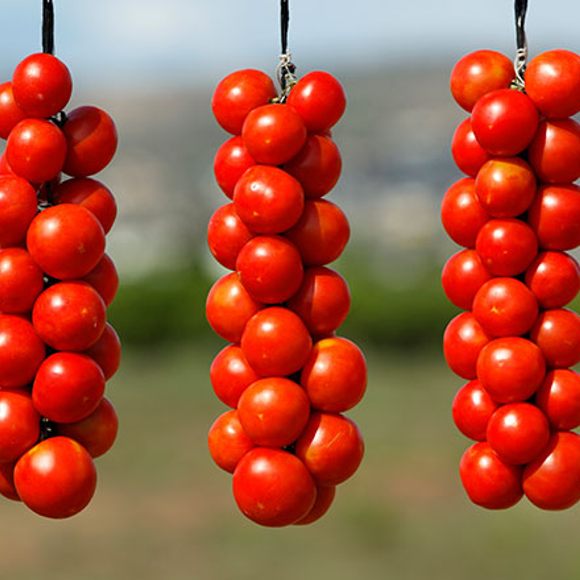Fruits & Vegetables
Hanging Tomatoes
This tomato variety can stay fresh for six months after harvesting.
Across Spain, but particularly in Catalonia, meals often include a simple dish of just four ingredients—bread, oil, salt, tomatoes. To prepare pan con tomate or, in Catalan, pa amb tomàquet, you grate garlic along the rough surface of a piece of bread, dribble on some olive oil, and then rub half a tomato over the bread. The fruit’s flesh soaks into the bread, creating a simple, luscious treat.
In this recipe, the tomato is the crucial ingredient. Pa amb tomàquet should be made with particular tomatoes called tomaquets de penjar, or hanging tomatoes, a variety that, when strung properly into bunches, can keep fresh for up to six months after being harvested. Which means that tomato season (and pan con tomate season) lasts long beyond summer: Harvest these tomatoes in September, and you can still eat fresh tomatoes in March.
Hanging tomatoes have special qualities that make them ideal for both preservation and spreading on toast. They’re extra juicy, so much so that they make poor slicing tomatoes. They also have thick skin, which helps protect the interior over those long months. If you slice one open and squeeze, the liquid easily spreads over bread. The hanging tomatoes grown in Alcalà de Xivert are particularly well known, and the area’s growers’ association protects and markets this particular tomato variety.
To survive for months, hanging tomatoes have to be stored in a special way. After the harvest, farmers sew them into clusters of 15 to 30 tomatoes. Ideally, no tomato should touch any other; if they’re packed too tightly, they can rot. This method isn’t perfect, but it’s successful enough to ensure access to fresh, juicy tomatoes and perfect pan con tomate almost year round.
Where to Try It
-
Alcalà de Xivert, Spain
Alcalà de Xivert, 12570, SpainThis town is well known for hanging tomatoes, and its growing association has official status as producers of hanging tomatoes.
Written By
 Sarah Laskow
Sarah Laskow















